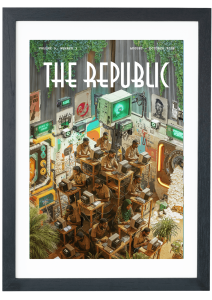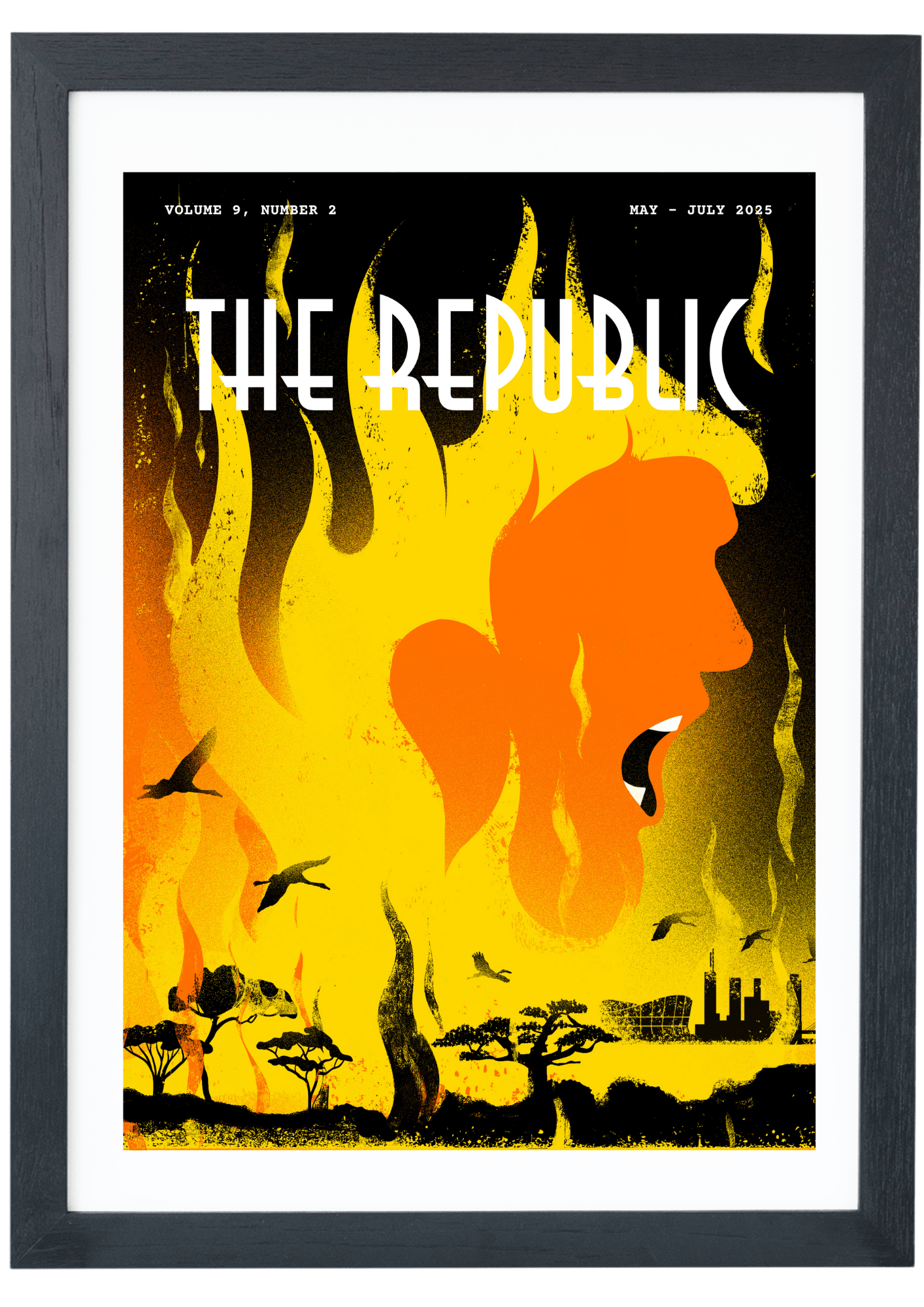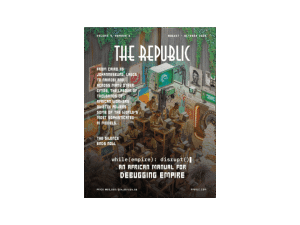
Photo Illustration by Ezinne Osueke / THE REPUBLIC. Source Ref: MUBI, YOUTUBE, IMDb.
THE MINISTRY OF GENDER x SEXUALITY
The Haunting State of Women’s Rights in the DRC

Photo Illustration by Ezinne Osueke / THE REPUBLIC. Source Ref: MUBI, YOUTUBE, IMDb.
THE MINISTRY OF GENDER X SEXUALITY
The Haunting State of Women’s Rights in the DRC
The Democratic Republic of Congo has had a tumultuous, harrowing history. Despite being one of the most mineral-rich countries in the world, the DRC has endured nearly two centuries of brutal exploitation, with each change in control merely sustaining the cycle of oppression. In the beginning, it was called the Congo Free State by King Leopold II of Belgium who claimed the land as his in 1885, legalized by the assent of the powers present at the Berlin conference, and who mobilized, through incredibly dehumanizing means, an ivory (and then, an increasingly profitable rubber) trade with the West. He created a quota system with mortal consequences; hands and feet were cut off if daily quotas were not reached. This barbaric model would lead to the death of millions and leave millions of others without their limbs.
After the Casement Report detailing the widespread mistreatment and death of the Congolese people was published in Britain in 1904, it formed a key part of Leopold’s finally letting go of the Congo State in 1908, leaving it in the hands of the Belgian Government, who then christened it the Belgian Congo. Leopold would die a year later.
It was during this colonial period, as with all of cinema’s incursion into the continent, that film came to Congo, not as a tool for entertainment or social justice, but to validate the colonial project, which in itself had become another subtler form of exploitation. This is one of the issues that Colette and Justin, a documentary film released in 2022 by Alain Kassanda, tries to engage and critique.
Colette and Justin doesn’t simply recount the past; the film invites reflection on how the colonial legacy continues to shape lived experiences today, particularly for Congolese women. The documentary became a lens through which I began to trace the persistent structures of violence and erasure that have long defined the country’s political and social landscape. This film led me to examine how the gendered dimensions of colonial oppression laid the groundwork for the ongoing systematic marginalization of women. This essay uses Kassanda’s film not as the central focus, but as a foundation for interrogating the continuity between the past and present forms of injustice.
ALAIN KASSANDA’S COLETTE AND JUSTIN
Alain Kassanda is a Congolese-French filmmaker based in Paris, France. Born in the Democratic Republic of Congo, he emigrated to France when he was 11. He was a film programmer on the outskirts of Paris for five years, programming for the theatre Les 39 marches in Sevran, and he started a festival, A hauteur d’enfant, which is based on films narrated from children’s perspectives. He started Ajimati Films, a Paris-based production company with Emilie Guitard, an anthropologist, seeking to engage political and social issues, challenging the already spun narratives about these issues. So far, he’s made three films; Trouble Sleep, an insightful character-driven portrait of the streets of Ibadan and those who walk the road; Coconut Head Generation, a look at the organizing activities of the Thursday Film Series film club in the University of Ibadan and the EndSARS Protests in Nigeria in 2020; and Colette and Justin.
Kassanda’s film is born of a need to engage Congolese history, his history and the injurious narratives born of colonial persuasion. The narrative is built on the many conversations he had with his grandparents about their lives as colonized peoples, their involvement in the struggle for independence and how they ended up living in Paris. This recounting of past happenings is interwoven with archival pictures and footage, creating a new understanding of what brought the Democratic Republic of Congo to the conditions of its very present day and ensuring continuity, which is key to his exploration of national and personal identity.
Kassanda’s excavation of memory is handled with care; he lays over his own narratives through the use of poetic voice-over, countering the very demeaning images that we find littered throughout the film. We find, in these archives, that the Belgian colonial authorities used film to create narratives of the Congolese people that were just not true, even going as far as to ask them to play the parts of savages in fictional films exported as documentaries. Films like De Boma à Tshela (1926) by Ernest Genval, Congo, terre d´eaux vives (1939) by André Cauvin and Yangambi (1943) by Gérard De Boe were meant to validate the colonial project, the missionary project, to validate the use of the Force Publique, the segregation of the Blacks and the whites, to validate the ceiling in civil service they created to keep the Congolese men beneath the whites in social standing and in economic power.
We also see how ethnic divides were created between people who spoke the same language, a technique which seems to be a trusty arrow in the quiver of colonial powers and resulted in the early foundations of instability in a country pushing for independence. The Baluba and the Lulua pitted against each other, all for subtler Belgian neocolonialism, for continued control of this mineral-rich country’s economic levers. We see people who voted for the first time in 1957 in three cities with political parties still forbidden, voting along ethnic lines as wanted by those Belgian overlords. This voting practice seems to have continued to occur in post-colonial DRC society, enough that an interrogation of this phenomenon was published a couple of years into the new millennium, with there also being cases of ethnic violence around electoral processes. We see a country clamouring for independence, with no real understanding of politics, because it was made so by the powers that be.
We also see, as part of the colonial divide and conquer, the formation of the black bourgeoisie, a crucial part of the Belgian push for economic control. These men working in the civil service and the service industry were required to have a merit card, one that proved their assimilation into the Belgian way of life (the civilized life) and, by extension, into Belgian polity.
This separation was key, as hierarchies are key to the infighting that classes will then produce. In 1958, 1500 out of 14 million people had this card. The ‘civilized Congolese’ dressed the right way (suits and wrap skirts), and the civilized Congolese man had a wife who did nothing but care for the home, an image of Congolese society, dictated of course by the Belgians.

shop the republic
AT THE INTERSECTION OF DOMINATIONS
A very important part of this new order was the colonial emphasis on the subjugation of women and the stripping of their agency. Colette, Kassanda’s grandmother, married at 14 and a half years, just out of the 7th grade, ending her education. The education itself wasn’t built for the agency of the girl child and the woman. The colonial setup was that women would be schooled up until the 7th grade, and then they would go to household school, where they would learn housekeeping, to iron, to wash, to take care of a husband and children; this was the curriculum-sponsored path for the women of Belgian Congo. They also invoked the familiar lines of divide. In Kassanda’s film, it is shown that women were taught separately from the men, in the local languages all around Belgian Congo. They were taught in Lingala, Tshiluba or Swahili, while the men were taught in French, effectively creating a language barrier if any woman harboured any thoughts of corporate work; only the men were allowed and schooled far enough to work. This meant that post-household school, there were only two (acceptable by the colonial powers) options for women: either get married and have a home or work for the nuns in the missions.
Adult women were only legitimate urban dwellers if they were married, widowed or elderly. Otherwise, these women were categorized as free women (femme libres), and they were taxed as income-earning prostitutes whether they were or not. At some point in the 1940s, the taxes these women, categorized without consideration, paid constituted the second-largest source of tax revenue for Stanleyville (now Kisangani in DRC).
When Belgium inaugurated Congo’s first university in 1954 (Lovanium), there were no women enrolled, and when independence came around six years later, there was only one woman in the entire country enrolled in secondary school, Sophie Kanza. She was also the first Congolese woman to receive a university education (though it was at the University of Geneva in Switzerland), bagging a diploma in Sociology in 1964 and also becoming the first woman minister in 1966, serving as the minister of Social Affairs.
Women were not allowed to vote until a law was passed in 1967, which recognized the right of all Congolese, irrespective of sex, to participate in voting. It would be another three years before a law on the legislative and presidential elections of 1970 supported suffrage as laid down three years before and formally gave both men and women the right to stand for election.
All of these limitations contributed to the view of women as property, as an addition to ease the lives of men, to serve and be controlled. It’s like Kassanda said in the film; the oppression was two-fold, colonial and in the hands of their male counterparts, as women.
At the intersection of dominations.
The economic decline under Mobutu in the 1980s and 1990s shifted the balance in households, with more families depending on the income brought in by women from their informal economic activities and more women working in the corporate world, but even then, laws like the Family code of 1988 stated that men were heads of the family unit and that wives had to get their husband’s permission to perform certain acts like get a job, open a bank account etc.
Even though the 2006 constitution represented a push for gender equality and new legislation on women’s rights and on issues such as the prevention of sexual violence was enacted, it is still not something that has found wide application, especially in conflict-torn areas of the DRC and in rural areas.
According to a UN report on the attainment of the Gender Equality Sustainable Development Goal (SDG) in the DRC, 29.1 per cent of women aged 20–24 years old who were married or in a union before age 18 and from that same report, as of February 2021, only 12.8 per cent of seats in parliament were held by women.
shop the republic
GENDER-BASED VIOLENCE IN THE CONGOLESE MINES
In the present day, Congolese cobalt, copper and uranium mines (particularly in the southern region of Haut-Katanga and Lualaba) are mostly controlled by Chinese interests who now own 15 of the 17 cobalt operations in the DRC. This dominance expanded as the United States, through corporate transactions during the Obama and Trump administrations, divested from significant mining interests in the region. Cobalt is used in the manufacture of lithium-ion batteries, which are used in many products, such as electric vehicles, tech devices and various types of electronics. Although Katanga is not the epicentre of armed conflict like the Kivu provinces, Human rights abuses are rampant in these mines, with women and children bearing the brunt of the day-to-day violence, all left unchecked by the Chinese mining companies.
China also has its vested interests in the instability of the region; The Congolese government is fighting with drones and weapons supplied by China and Chinese contractors are also supplying the Uganda People’s Defence Forces with weapons for military operations on Congolese soil against the Uganda rebels of the Allied Democratic Forces.
The major conflict has been between the country’s military and the M23 rebel group (allegedly funded by Rwanda), operating in the North Kivu Province in the Eastern part of the DRC, but the protracted conflict is far from simple. The constant arming and counter-support from the Congolese government and those foreign interests means that there are now over a hundred armed militias constantly vying for control in the DRC, in the mineral-rich areas in the East. These militias seek to control gold and 3T mines to finance their wars and further their interests. Foreign figures like Dan Gertler, David Bensusan, John Crawley, Chris Huber and others who have set up illegal trading networks and price monopolies are very influential in the region, (with Bensusan infamously known for transporting Congolese minerals across the DRC border to Rwanda for foreign buyers) and continue to profit from the instability, with other local armed groups benefiting from the networks they have created. In 2009, the International Tin Association, with the subsequent participation of the Tantalum-Niobium International Study Centre, set up the International Tin Supply Chain Initiative (ITSCI) to provide a reliable chain of custody of minerals that are not linked to child labour, the influence of armed groups or the army. Despite the association’s aims and pledges, ITSCI’s system has permitted the laundering of tainted minerals in DRC, with its incident reporting frequently appearing to downplay or ignore incidents that seriously compromise its supply chain.
Rwanda and Uganda, alongside militias they fund, have financial and territorial interests in these Congolese mines and, as such, are at the root of the violence and instability in the region. Despite concerns about Rwandan foreign policy, the fact that Rwanda has blatantly plundered the DRC’s minerals since the 1990s, and has continued to support the infliction of untold violence-for-profit in the region supporting the M23 rebels, Rwanda still receive Western support. This remains true even as the recent escalation of the conflict has led to a series of sanctions against the country of a thousand hills. This, in turn, indirectly influences the situation in the DRC, effectively strengthening their interests in the country.
The people in these regions are not considered in the violence of things. People have lost their homes, forcibly evicted by armed forces due to mining expansion projects.
Because of the poverty in the area (An estimated 74.6 per cent of Congolese people lived on less than $2.15 a day in 2023), many turn to artisanal mining to feed their family, a big percentage of them women and children. Artisanal mining employs 2 million people in the DRC, and the work is done with little to no protection. Women and children, kidnapped by militias who have trafficking pipelines for the mines, work long hours, sniffing toxic dust and chemicals, digging with inadequate tools, and sometimes, their hands, piled in pits, trying to earn an extra dollar a day. There are collapses in these mines, with thousands losing their lives or losing limbs to the tunnels, but they have no choice; many of them have been internally displaced by mining expansion projects. Others have nowhere else to turn; more have families to feed. Armed forces who facilitate some of the illegal mining operations also take advantage of women miners, subjecting them to gender-based violence. There are cases of women miners who are raped by other civilian miners in the pits, and those who cannot read and don’t know enough about the legal requirements of working in the mines, are often taken advantage of because of that.
As the battle for the country’s resources heightens, the well-being of thousands of women mining for their daily sustenance worsens. The story of violence in Congo’s mining regions is not simply one of old warlords or new investors, it is the story of an entire system that profits from chaos, where resource extraction and human destruction go hand in hand. And without concerted action to dismantle this system, the cycle of exploitation and gendered violence will only continue.
shop the republic
-
‘The Empire Hacks Back’ by Olalekan Jeyifous by Olalekan Jeyifous
₦70,000.00 – ₦75,000.00Price range: ₦70,000.00 through ₦75,000.00 This product has multiple variants. The options may be chosen on the product page -
‘Make the World Burn Again’ by Edel Rodriguez by Edel Rodriguez
₦70,000.00 – ₦75,000.00Price range: ₦70,000.00 through ₦75,000.00 This product has multiple variants. The options may be chosen on the product page -
‘Nigerian Theatre’ Print by Shalom Ojo
₦150,000.00 -
‘Natural Synthesis’ Print by Diana Ejaita
₦70,000.00 – ₦75,000.00Price range: ₦70,000.00 through ₦75,000.00 This product has multiple variants. The options may be chosen on the product page
shop the republic
THE WAY FORWARD
In a country where cultural stereotypes about the place and standing of women in society prevent any real progress in women’s rights nationally, it is important to reorient the minds of the people in whatever ways it can be done. Some people and organizations are trying to draw global attention to this growing abuse of women. In Congolese Cinema, there have been films who explore and document the gross abuse of women’s rights and the rape epidemic perpetuated in the conflicts.
Breaking the Silence is a documentary film that tells the stories of Congolese women and girls that have been raped and their physical and psychological trauma. It also touches on the difficulties in getting justice, even when the law is on your side.
In 2009, to raise awareness and encourage dialogue about sexual abuse in the country, the United Nations High Commission for Refugees and Search for Common Ground organized community screenings of the film.
American filmmaker, Lisa Jackson made The Greatest Silence: Rape in the Congo in 2007, a documentary film about rape survivors in the regions affected by the Second Congo War, providing a harrowing account (and personal) of the lives of these women and their struggles.
Seeds of Hope (2013), a documentary film by Fiona Lloyd-Davies, tells the story of a woman named Masika, who herself a victim of multiple rapes, ran a centre of healing for rape survivors and children born from rape, creating a community that sustains itself. Unfortunately, she passed, but the centre is now run by Désanges Kabuo Kamate, her daughter, herself a survivor of sexual violence.
L’homme qui répare les femmes: la colère d’Hippocrate (or The Man Who Mends Women: The Wrath of Hippocrates) is a 2015 documentary film by Thierry Michel that explores the life and work of Doctor Denis Mukwege. As far back as 2003, organizations have been clamouring for movements towards gender equality in the DRC. The Committee on Elimination of Discrimination against Women (housed within the Ministry of Agriculture, Livestock and Fisheries at the time) had noted improvements but called on the Congolese government of the time to make more provisions across all the worrying areas.
The Kvinna till Kvinna Foundation has been championing women’s rights and supporting women in the DRC since 2009. They have worked in challenging some of the discriminatory laws in Congo, and they have lobbied, alongside their partners in the country (like Nothing Without Women (Rien sans les Femmes), a feminist organization formed in 2015) for women’s political participation, economic independence, for gender-equality laws and preventing and responding to Gender-based violence. They aim to continue to create lasting change for the women of the Democratic Republic of Congo, and there have been promising moves forward with their advocacy, leading to a new gender equality law being passed.
Some parts of the existing mining code are comprehensive and developed for various aspects of the mining process, but the challenge lies in the implementation of these laws in a region consistently destabilized by corruption, foreign and vested interests, whose profitability lies in the continued chaos of the war.
For the mining operations in the unstable eastern part of the country, there is a pressing need for mining regulations and structures that are specifically targeted at the protection of women working around and in the mines. It’s difficult to currently broach that with the complexities of vested interests, but to curb these abuses, there needs to be protection for the vulnerable women miners.
Individuals of influence like John Crawley and Dan Gertler exert significant control, and they are quite happy to maintain the current state of things, which allows them to operate unchecked, exploiting the people and the country’s resources with impunity. Gertler, who has been exploiting with impunity since 1997, was sanctioned by the US Treasury in 2017 and 2018, accusing him of leveraging his friendship with former Congo president Joseph Kabila to secure lucrative mining deals. There have now been talks between the DRC’s government and the US government to lift sanctions on him, a move that has been criticized by anticorruption NGOs in the DRC, who argue that removing the sanctions placed on him and his companies could send a message of impunity to the companies he works with, reinforcing a dearth of consequences for corruption, environmental and human rights abuse. Maintaining sanctions on an individual like this will only promote accountability and transparency in the mining sector in the DRC, going forward.
Rwanda’s occupation of strategic mining areas like Rubaya and Bunagana, an important cross-border trading centre between the DRC and Uganda, is detrimental to the DRC’s economic freedom and potential. The governments of both Rwanda and Uganda (led by Paul Kagame and Yoweri Musuveni respectively) are both complicit in the continued instability in the DRC (and resultant vulnerability of women and children) and must be addressed through targeted sanctions, in order to bring reprieve to a region embattled, and start a path towards peace and stability.
The informal trade routes from the DRC to Rwanda and Uganda also bring in a lot of revenue, with the Rubavu-Goma border bringing in 133 million dollars in unofficial exports in 2022, making it one of the most valuable informal trade routes in the world. While some of the items traded on the route are foodstuffs needed in the DRC due to war-disrupted farming, there have been cases where minerals are also smuggled across the border. These routes continue to incentivize smuggling due to favourable export taxes in neighbouring countries. There must be immediate consideration for the creation and implementation of a regional tax reform, needed to formalize and regulate these trade practices to ensure that the DRC benefits from its mineral resources.
Just as Kassanda sought to engage his Congolese history, once the government and the international community begin to engage these truly harrowing conditions of living for the woman and the girl-child in Congo, we will begin to see change occur at the legislative level to further protect these vulnerable demographic and harmful laws to the agency and autonomy of women in DRC being repealed.
There needs to be real consequences for the perpetrators of these crimes against women, and slowly, but surely, the DRC will move towards being a safer place for women⎈
BUY THE MAGAZINE AND/OR THE COVER
-
‘Natural Synthesis’ Print by Diana Ejaita
₦70,000.00 – ₦75,000.00Price range: ₦70,000.00 through ₦75,000.00 This product has multiple variants. The options may be chosen on the product page















